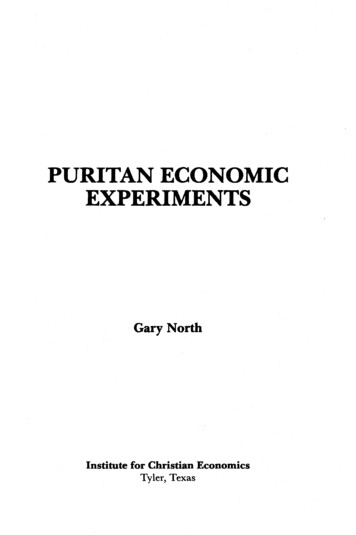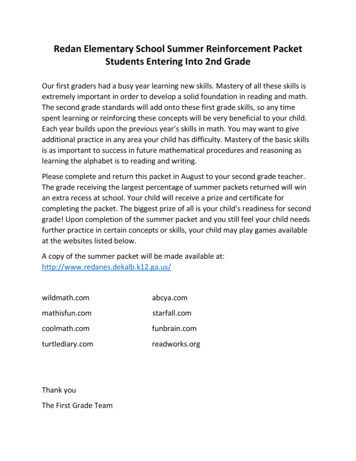
Transcription
neonatalVol. 35 No. 1Winter 2022INTENSIVE CARE
No Challenge Too Big.No Patient Too Small.Discover the Masimo SET DifferenceFor over 25 years, Masimo has been a trusted partner in neonatal and newborn care around the world—delivering innovative Masimo SET Measure-through Motion and Low Perfusion pulse oximetry toenhance care even in challenging conditions.Today, we remain committed to protecting your most delicate patients and strive to deliver a variety ofspecially tailored solutions that meet their needs and help you improve outcomes.To learn more about how SET is making a difference for neonates, visit masimo.com/newborn-careCaution: Federal (USA) law restricts this device to sale by or on the order of a physician. See instructions foruse for full prescribing information, including indications, contraindications, warnings, and precautions. 2021 Masimo. All rights reserved.PLCO-005107/PLMM-12056A-0621PLLT-11507A
Full Line of Suction TipsMade in the USA and Ready to ShipTRY THEMFOR FREE!VISITneotech-neonatalic.comN204Little Sucker ORAL AND NASAL SUCTION DEVICELittle Sucker Nasal TipN205NASAL SUCTION DEVICENeoSucker CurvedORAL AND NASAL SUCTION DEVICEN205CN225Neotech offers a family of oral and nasalsuction devices. They are designed for singlehanded suctioning and feature a patentedthumb port for intermittent suctioning. Eachhas a soft flexible tip, similar to a bulb syringe.The Little Sucker is made in the USA. Orderyour free sample today.N207 2022 Neotech Products LLC. All rights reserved.Request your free samples online at neotech-neonatalic.comMade in USA
Editorial Advisory BoardVol. 35 No. 1Winter 2022Table of ContentsDepartments56NewsCompany n-invasive Blood PressureMonitoring of NeonatesEnd-of-life Decision and Length ofStay in NICUBlood Loss in the NICUAre Flavonoids Effective ForPerineal Pain And Safe?NICU Noise: 50 Years of WorryGot Milk? Increasing Mom’s MilkVolumesUtilizing Clinical Data to EnableBetter Ventilation ManagementHow NICUs Are Tailoring TheirApproach to Care for the TiniestBabiesElectronic Alerts on the SocialDeterminants of HealthLeveraging Family EngagementTechnologyAquapheresis Offers Hope toPreterm NeonatesB. infantis EVC001 is WellToleratedPediatric Respiratory StabilityCost-Effectiveness of TargetedFortification Approach VersusStandard Fortification ApproachExamining the Impact of EarlyFortification on Growth RatesRespiratory Distress and AbnormalCT Scan in a Newborn InfantArie L. Alkalay, MDClinical Professor of PediatricsDavid Geffen School of MedicinePediatrician, Cedars-SinaiLos Angeles, CALeslie B. Altimier, DNP, MSN, BSN, RNC,NEA-BCSenior Director of Clinical Innovation &Research, MasimoIrvine, CAM. A. Arif, MDProfessor of Pediatrics & Head, NeonatologyNational Institutes of Child HealthKarachi, PakistanMuhammad Aslam, MDAssociate Professor of PediatricsUniversity of California, IrvineNeonatologist, UC Irvine Medical CenterOrange, CAEdward Austin, MDAustin-Hernandez Family Medical CenterCompton, CARichard L. Auten, MDAssistant Professor of PediatricsDuke University Medical CenterDurham, NCBruce G. Bateman, MDDepartment of Obstetrics & GynecologyUniversity of VirginiaCharlottesville, VASandy Beauman, MSN, RNC-NICCNC ConsultingAlbuquerque, NMDavid D. Berry, MDWake Forest University School of MedicineWinston-Salem, NCMelissa K. Brown, BS, RRT-NPS, RCPFaculty, Respiratory Therapy ProgramGrossmont CollegeEl Cajon, CAD. Spencer Brudno, MDAssociate Professor of PediatricsMedical Director, Pediatric TherapyMedical College of GeorgiaAugusta, GACurtis D. Caldwell, NNPUNM School of Medicine, Dept of PediatricsAlbuquerque, NMEd Coombs, MA RRT-NPS, ACCS, FAARCMarketing Director – Intensive CareKey Application Field Manager –Respiratory Care, Draeger MedicalTelford, PAJonathan Cronin, MDAssistant Professor of PediatricsHarvard Medical School ChiefNeonatology and Newborn Medicine UnitDepartment of PediatricsMassachusetts General Hospital for ChildrenBoston, MAMichael P. Czervinske, RRTNeonatal and Pediatric Critical CareUniversity of Kansas Medical CenterKansas City, KSProfessor Adekunle H. DawoduDirector, International Patient Care andEducation, Cincinnati Children’s HospitalCincinnati, OHJayant Deodhar, MDAssociate Professor of Clinical PediatricsChildren’s Hospital CenterCincinnati, OHLeonard Eisenfeld, MDAssociate Professor of PediatricsUniversity of Connecticut School of MedicineDivision of NeonatologyConnecticut Children’s Medical CenterHartford, CTSami Elhassani, MDNeonatologistSpartanburg, SCIvan Frantz, III, MDChariman of Department of PediatricsChief, Division of Newborn MedicineTufts University School of MedicineBoston, MAPhilippe S. Friedlich, MDAssociate Professor of Clinical PediatricsChildren’s Hospital of Los AngelesLos Angeles, CAG. Paolo Gancia, MDNeonatologist, Terapia IntensivaNeonatale-Neonatologia, Cuneo, ItalyGeorge A. Gregory, MDProfessor of Pediatrics and AnesthesiaUniversity of CaliforniaSan Francisco, CACharles J. Gutierrez, PhD, RRT, FAARCNeurorespiratory Clinical Specialist, J.A.Haley VA Hospital and Assistant Professor,Pulmonary, Critical Care & Sleep Medicine,Morsani College of Medicine, University ofSouth Florida, Tampa, FLWilliam R. Halliburton, RRT, RCPNeonatal Respiratory Care CoordinatorDepartment of Respiratory CareHillcrest Baptist Medical Center, Waco, TXMary Catherine Harris, MDAssociate Professor of PediatricsDivision of NeonatologyUniversity of Pennsylvania School of MedicineThe Children’s Hospital of PhiladelphiaPhiladelphia, PADavid J. Hoffman, MDClinical Associate Professor of PediatricsPenn State College of MedicineStaff NeonatologistThe Reading Hospital and Medical CenterWest Reading, PAMichael R. Jackson, RRTNewborn Intensive Care UnitBeth Israel Hospital, Boston, MAChang-Ryul Kim, MDAssociate Professor of PediatricsCollege of MedicineHanyang University Kuri HospitalSeoul, South KoreaDavid M. Kissin, BS, RRTPerinatal/Pediatric SpecialistMaine Medical Center, Portiand, MESheldon Korones, MDDirector of Newborn CenterCollege of Medicine, Memphis, TNScott E. Leonard, MBA, BA, RRTDirector of Respiratory Therapy, EEG,NeurophysiologyGeorge Washington University HospitalWashington, DCRaymond Malloy, MHA, RRTDirector of Pulmonary CareThomas Jefferson University HospitalPhiladelphia, PAPaul J. Mathews, PhD, RRT, FCCM, FCCP,FAARCAssociate Professor of Respiratory CareUniversity of Kansas Medical CenterKansas City, KSWilliam Meadow, MDProfessor of PediatricsCo-Section Chief, NeonatologyComer Children’s HospitalThe University of Chicago, Chicago, ILDavid G. Oelberg, MDCenter for Pediatric ResearchEastern Virginia Medical SchoolChildren’s Hospital of The King’s DaughtersNorfolk, VARahmi Ors, MDDirector, Department of Neonatology andPediatricsProfessor of Pediatrics and NeonatologistMeram Medical FacultyNecmettin Erbakan UniversityKonya, TurkeyT. Michael O’Shea, MD, MPHChief, Neonatology DivisionWake Forest University School of MedicineWinston-Salem, NCLisa Pappas, RRT-NPSRespiratory Clinical Coordinator NICUUniversity of Utah HospitalSalt Lake City, UTG. Battisita Parigi, MDAssociate Professor of Pediatric SurgeryUniversity of Pavia, ItalyRichard Paul, MDChief, Maternal & Fetal MedicineDepartment of Obstetrics & GynecologyUniversity of Southern CaliforniaLos Angeles, CAMax Perlman, MDProfessor of PediatricsThe Hospital for Sick ChildrenToronto, Ontario, CanadaBoris Petrikovsky, MDDirector, Prenatal Diagnostic Unit ServicesNew York Downtown HospitalNew York, NYArun Pramanik, MDProfessor of PediatricsDirector of Neonatal FellowshipLouisiana State UniversityHealth Sciences Center, Shreveport, LABenamanahalli K. Rajegowda, MDChief of NeonatologyLincoln Medical and Mental Health CenterProfessor of Clinical PediatricsWeill Medical College of Cornell University,NYRuben D Restrepo, MD RRT FAARC FCCPCoordinator of ResearchProfessor - Division of Respiratory CareUT Health San Antonio7703 Floyd Curl Dr, San Antonio, TXKoravangattu Sankaran, FRCP(C), FAAP,FCCMProfessor of Pediatrics and Director ofNeonatology and Neonatal ResearchDepartment of PediatricsRoyal University HospitalUniversity of SaskatchewanSaskatoon, Saskatchewan, CanadaIstvan Seri, MD, PhDProfessor of PediatricsHead, USC Division of Neonatal MedicineUniversity of Southern California,Los Angeles, CATushar A. Shah, MD, MPHDivision of NeonatologyCincinnati Children’s Hospital Medical CenterCincinnati, OHDave Swift, RRTOttawa Hospital – Civic SiteCampus Coordinator (Professional Practice) &Special Care Nursery Charge TherapistRespiratory Therapy Team LeadNational Office of the Health Care EmergencyResponse Team (NOHERT)Subject Matter Expert, Health CanadaJack TannerNICU Clinical CoordinatorU Mass Memorial HospitalWorcester, MAOtwell D. Timmons, MDCarolinas Medical CenterCharlotte, NCMaya Vazirani, MD, FAAPBoard Certified Neonatology and PediatricsLancaster, CAMax Vento, MDAssociate Professor of PediatricsChief, Pediatric ServicesNeonatologia Hospital Virgin del ConsueloValencia, SpainDharmapuri Vidyasagar, MDProfessor of PediatricsDepartment of PediatricsUniversity of IllinoisChicago, ILneonatal INTENSIVE CARE Vol. 35 No. 1 Winter 2022n
NewsWinter 2022New York First to Add G6PD Deficiency to RoutineScreeningsNew York State became the first state in the nation to add G6PDDeficiency to routine newborn screenings today, as New YorkState Governor Kathy Hochul signed the Brody James Bill intolaw. The bill, supported by The g6pd Deficiency Foundation,was named for two people whose lives were altered becauseG6PDd was not diagnosed until after it had caused severe healthimpacts. G6PDd (short for Glucose-6-Phosphate DehydrogenaseDeficiency) is the most common human enzyme disorder,affecting upwards of an estimated 400 million people worldwideand up to 6% of newborns in the US. G6PD Deficiency canhave life-altering effects if it’s not caught early and proactivelycontrolled. “We are so grateful to Governor Hochul, as well asSenator Rivera and Assemblyman Gotfried, for helping us makeNew York State a safer place for newborns and their familiesthrough the Brody James Bill,” said Keely Harris, Founder andPresident of The g6pd Deficiency Foundation. “I’m proud thatthis law will honor my grandson’s journey and help preventG6PDd from causing life-changing injuries to other children likehim. New York State has once again proven itself to be a leaderon children’s health issues, and we hope to see other statesfollow its example so that families around the country mighthave some protection from the life-threatening crises caused byG6PDd.” The bill, introduced by State Senator Gustavo Riveraand Assemblyman Richard Gotfried, is the first of its kind in theUnited States, although many countries around the world includethis screening for newborns, as does the US military as part ofits routine medical assessment. It was inspired by the story ofKeely’s now 8-year-old grandson Brody and another individual,James, who recently passed at 20 years old, due to complicationsfrom brain damage, caused by undiagnosed G6PDd as anewborn. In Brody’s case, after a harrowing experience withundiagnosed G6PD Deficiency that led to kernicterus, 1-weekold Brody suffered brain damage that could have been avoidedif he were screened at birth and diagnosed before he wasdischarged from the hospital. In response to the family’s ordeal,and in honor of her grandson’s ongoing battle, Keely foundedThe g6pd Deficiency Foundation which aims to raise awarenessfor the disease for both families and medical professionalsand promotes newborn screenings as a life-saving tool. G6PDdeficiency is an inherited genetic enzyme disorder that impactsthe mechanism by which the body is able to process glucose.The majority of individuals who are G6PD deficient have noobvious clinical symptoms in the absence of “triggers” (such asprimaquine or a reaction to fava beans) and are often unawarethat they have this deficiency. G6PD deficiency has, however,the potential to cause attacks of acute hemolytic anemia, severeneonatal jaundice that can lead to kernicterus, and, more rarely,chronic anemia called Chronic Non-Spherocytic HemolyticAnemia (CNSHA). A letter supporting the bill, written and signedby Dr. Richard O. Francis, Associate Professor, Departmentof Pathology & Cell Biology, Columbia University VP&S andDirector of Special Hematology and Coagulation Laboratoryat New York-Presbyterian Hospital-Columbia University IrvingMedical Center stated, “Because testing for G6PD deficiency isnot a part of New York State newborn screening, many timesthe infant who is not known to be G6PD-deficient is already athome while hyperbilirubinemia is developing and brain damageis occurring. Prior to the infant’s discharge from the hospital,if the clinician knew that the newborn was G6PD deficient,proper treatment and parental education could occur, therebypreventing the development of kernicterus. A lifetime ofunexplained sickness and unnecessary hospitalizations could beavoided for the infant and his or her family members if screeningManaging EditorChristopher HiscoxSenior EditorVincent TerrierISSN 1062-2454Published five times each year byGoldstein and Associates,Inc.News EditorChris CampbellAssociate EditorJordana Hammeke, Susan GoldsteinCirculation, Coverage, AdvertisingRates: Complete details regardingcirculation, coverage, advertising rates, spacesizes, and similar information are availableto prospective advertisers. Closing date is 45days preceding date of issue.10940 Wilshire Blvd., Suite 600Los Angeles CA 90024Phone: 310-443-4109Fax: 310-443-4110E-mail: s.gold4@verizon.netWeb: www.nicmag.caChange of Address: Notices should besent promptly to Circulation Department.Provide old mailing label as well as newaddress; include zip code or postal code.Allow two months for change.Publisher/Editor in ChiefSteve Goldsteinneonatal INTENSIVE CARE Vol. 35 No. 1 Winter 2022nEditorial Contributions may besent by e-mail and will be handled withreasonable care: however, publishersassume no responsibility for safety of artwork, photographs, or manuscripts. Everyprecaution is taken to ensure accuracy, butthe publishers cannot accept responsibilityfor the correctness or accuracy ofinforma tion supplied herein or for anyopinion expressed. Editorial closing date isthe first day of the month preceding monthof issue. 2022 by Goldstein & Associates, Inc. Allrights reserved. Reproduction in whole orin part without written permission is strictlyprohibited.Cover: H. Lyman Saÿen, Fugue, 1915, oil oncanvas, Smithsonian American Art Museum,Gift of H. Lyman Sayen to his nation,1967.6.95
for G6PD deficiency is performed at birth.” G6PD Deficiency ismore common in families with Mediterranean, Asian or Africanancestry and disproportionately impacts minority communities.However, in the 21st century, ancestry is not always knownor clear. In absence of a screening or parental blood testsspecifically for this genetic mutation, it is impossible to identifya G6PD deficient person. Adding universal screenings for G6PDdto the newborn screening list, along with Cystic Fibrosis andSickle Cell Disease, would allow it to be diagnosed and treatedearly, saving lives, and sparing families unnecessary pain.loss, deafness requiring a hearing aid or cochlear implants,major language or speech problems, or cognitive delay at 2years corrected age. The median time to clamping was 60seconds in the delayed group and 5 seconds in the immediategroup. Primary outcome data were available for 1,419 infants.Death or major disability occurred in 29% of infants assignedto delayed clamping compared to 34% of those assigned toimmediate clamping (relative risk 0.83, P .010). The infantswere part of the APTS Childhood Follow-Up Study, an open-labelContinued on page 8 Fetal Gut May Have Insulin-Producing Cells That Shut Offat BirthCOMPANY PROFILEIn addition to pancreatic beta cells that secrete insulin,researchers have found that fetal cells in the gut secrete insulinproteins, but neonatal cells do not, suggesting that this ability isturned off at birth.The study findings are “plausible, because the pancreas andthe small intestine originate from the same tissue in the growingfetus at about the fifth week of gestation,” said senior studyauthor Shalev Itzkovitz, PhD, principal investigator, WeizmannInstitute of Science, in Rehovot, Israel, in a news story in TheJerusalem Post. The study by Adi Egozi, a PhD student at theWeizmann Institute of Science and colleagues in Israel and inthe United States, was recently published in Nature Medicine.The researchers speculated that if they could get cells in adultsto secrete insulin proteins, this might lead to a new way totreat diabetes, but this research is very preliminary. “We foundinsulin-producing cells in fetuses, yet not in neonates,” Itzkovitzsummarized in an email. “It would be exciting to uncoversituations where the insulin-producing cells naturally re-appear,eg, in diabetes, gastric bypass, or other perturbations,” and to“identify molecules that could awaken the beta-like state wediscovered,” Itzkovitz added. The study findings “highlight apotential extra-pancreatic source of beta cells and expose itsmolecular blueprint,” the researchers summarize. “The dream isto have a drug that could re-awaken the fetal insulin-expressingprogram,” Itzkovitz said. “Even though the insulin-producingcells are a minority, the gut surface is huge, and their numbersadd up,” he noted. In addition, “gut cells are constantly replacedvia divisions of stem cells.” “This means that the impact ofautoimmune attack in type 1 diabetes might be less pronouncedon intestinal insulin-producing cells,” according to Itzkovitz.Delayed Umbilical Cord Clamping Improves Outcomes inVery Preterm InfantsDelayed umbilical cord clamping for at least 60 seconds afterbirth significantly reduced death or disability in infants of lessthan 30 weeks’ gestation, according to data from nearly 1,500infants. The burden of disability and mortality for babies bornbefore 30 weeks’ gestation remains high, especially in low- andmiddle-income countries, wrote Kristy P. Robledo, PhD, ofthe University of Sydney, Australia, and colleagues. Delayedclamping of the umbilical cord is a simple procedure that mayimprove mortality in this population, but more research isneeded; recommended times to delayed clamping range from30 seconds to 3 minutes, they noted. In a study published in TheLancet Child & Adolescent Health, the researchers randomized767 very preterm infants to delayed clamping at least 60seconds after birth and 764 to immediate clamping. Of these,384 were multiple births (who were individually randomized),862 were male, and 505 were born before 27 weeks’ gestation.The primary outcome was death or disability at 2 years of age.Major disability was defined as cerebral palsy, severe visual6NeoChildDescribe your product(s) and its unique features.NeoChild offers various specialty neonatal/pediatric devices,including two safety enteral feeding systems, customconvenience kits, and various infusion sets. NeoChild’sSAFEkey System is our newest product offering and is the nextgeneration for safety enteral feeding systems, providing clinicaladvantages, cost savings, and usability benefits.Tell us about the latest advances in the area your productserves.NeoChild has taken the steps to vertically integrate ourmanufacturing/capacity to alleviate supply chain issuesand backorder situations. This decision will not only allowNeoChild to control our product quality but facilitate supplychain logistics. These advances also allow NeoChild to providecustomized convenience kits to meet each hospital’s uniqueneeds.Discuss your R&D process, including clinical user input.NeoChild closely works with clinicians in the specializedfield of neonatal medicine and adheres to medical basedevidence supporting all products. NeoChild is a pioneer inthe development of enteral feeding devices that emphasizethe continuum of care in newborns’ health. Research anddevelopment emphasizing efficacy, safety and improving clinicaloutcome are reviewed/advocated by global thought leaders in theneonatal space.Discuss the educational services you offer for use of yourproduct.NeoChild offers training videos, literature, in-servicing, andvarious tutorials.What new technology do you see as having the greatestimpact on your area of expertise?NeoChild’s SAFEkey System is the newest generationof safety enteral feeding systems and takes NeoChild’sSafe Child System , the original and only patented legacysystem, to the next generation of enteral feed safety. Byeliminating misconnections, the SAFEkey System adds alocking design outside of the fluid pathway to not only eliminatedisconnections, but also eliminate the dead space (moat) areaassociated with ENFit connectors. Eliminating the moat areanegates the need to brush clean potential bacteria growthconcern. In addition, NeoChild’s SAFEkey System providesimportant operator benefit while extending a price savingsadvantage versus ENFit device.neonatal INTENSIVE CARE Vol. 35 No. 1 Winter 2022n
It’s more than Tape,TMIt’s Baby Tape PLUS !New From B&B Medical Technologies!Baby Tape PLUS Hydrocolloid Infant EndotrachealTube Holder Hydrocolloid adhesive is gentle on babies’ delicate skin Pre-cut, pre-packaged Tapes reducetime to secure endotracheal tubes Versatile design fits a wide range of infants Can also be used to secure nasogastric /orogastric tubes & cannulasB&B Products are also available through finer specialtydistributors including: Tri-anim, Cardinal Health & Medline. 2021 B&B Medical Technologies. All Rights Reserved.
News continued from page 6superiority trial conducted in Australia and New Zealand. By age2 years, 8% of infants in the delayed group and 11% of those inthe immediate group had died; 23% and 26%, respectively, metcriteria for major disability. The impact of delayed clampingtranslates to a 30% reduction in relative risk of mortality at 2years of age, but no significant impact on major disability, theresearchers wrote. The findings were limited by several factorsincluding the unblinded study design, lack of data on heart rateor time to first breath, and the clamping prior to 60 seconds in26% of infants in the delayed group based on clinical concernsfor these specific infants, the researchers noted. However, theresults were strengthened by the large size, low risk of bias, andspecific primary outcome, they said. The data support findingsfrom recent systematic reviews and highlight the need for furthertrials to evaluate delayed clamping at different time points, withlarger populations, inclusion of time to first breath and heartrate, and improved measures of disability, the researchers added.Spreading Holiday Cheer: NICU Babies ‘Sleigh-ing It’ inUgly SweatersHoliday merriment in a place often associated with trauma ispart of the festivity of the winter season at Tallahassee MemorialHealthCare (TMH) in Tallahassee, Florida. As is their tradition,the nurses in the neonatal intensive care unit (NICU) at TMHdressed up their newborn patients in holiday attire. This year,they chose the “ugly sweater” look for the tiniest of hospitalstayovers. About 20 baby photos grace the hospital’s Facebookpage, starting with a Grinch baby and ending with one dressedas a candy cane. The photos are “live and full of just as muchcuteness as ever,” marketing representative Morgan King said.The Facebook post, in keeping with custom, was full of punsto keep spirits high around an otherwise stressful environment.For starters: “There’s snow way we would miss our favoriteholiday tradition! This year, our NICU babies are sleigh-ing itin their ugly Christmas sweaters.” An explanation beside theGrinch photo stated: “These NICU babies are so cute, they madeour hearts grow three sizes.” Another photo joked: “What’s asnowman’s favorite hot drink? Frost-tea.” And aside a babysporting a Christmas-tree costume: “We hope these babiesreally light up your day.” The post continued, “Thank you toour incredible NICU team who always go above and beyond tomake the holidays special for our NICU families. The sweaterswere hand-made by our NICU team to help these little cutiesand their families get in the holiday spirit.” The parents of allbabies pictured consented to their children being dressed up andphotographed, the post further clarified. Earlier this year, NICUnurses took to Facebook with festive Halloween costumes forthe babies under their care in a post that went viral, attractingnational headlines. TMH has the only NICU and high-risklabor and delivery unit in the region, King said. “In additionto providing sick and premature babies the highest level ofspecialized care, our team works to make the NICU environmentas comfortable as possible for our babies and families,” she said.“Having a baby in the NICU can be unexpected and challengingfor families, making the holidays feel less merry. Bringing thefestive fun to these little ones and their parents through thisannual tradition is just one of the many ways our team worksto normalize the NICU environment and make an uncertaintime special for families. Our crafty NICU night team createdthe sweaters and our day team helped bring their visions tolife.” Among the comments under the post, one visitor shared:“Praying for these special little ones and their families! Theyare rocking the sweaters!” The post ended with a disclaimer8to use caution with fragile little ones. “Please remember, youshould always place your little ones on their backs to sleep,with nothing else in the crib. These NICU babies have specialcircumstances and are monitored 24/7 by our skilled nursingteam.”Program Assists Substance-Exposed Infants, TheirCaregiversPregnant with her second child, Clarissa Collins was at hermethadone clinic when a woman walked in with a box ofdoughnuts and a baby doll. The woman, Tara Sundem, waspartway through a five-year effort to open Hushabye Nurseryand launch a novel family-focused program that would treatsubstance-exposed infants and offer care and support to theircaregivers. Hushabye Nursery recently celebrated one yearin its current care facility in Phoenix and Collins now worksthere as a peer support specialist, helping others in recovery,the Arizona Capitol Times reported. The center houses a 12room inpatient nursery for infants suffering from neonatalabstinence syndrome — newborns experiencing withdrawalfrom opioids they were exposed to in the womb, such as heroinand prescription painkillers. But on that day in 2019, Collinsbegrudgingly attended Sundem’s support group for pregnantwomen with opioid use disorder. By the second group meeting,she decided to come back every week. “I looked forward to it.I wanted to see the other girls; I wanted to hear their stories.I wanted to meet the baby,” Collins said. “And we becamethis little family. We became very close friends.” As the opioidepidemic worsens nationwide, neonatal abstinence syndrome(NAS) cases are increasing, too. Nationally, the number ofbabies born with the condition increased 82% from 2010 to 2017,according to the Centers for Disease Control and Prevention.The national trend in NAS cases holds true in Arizona and hasworsened since the Covid pandemic began. Arizona’s NAS ratein 2020 was 9.1 per 1,000 newborn hospitalizations, up from5.67 per 1,000 in 2015, according to Arizona Department ofHealth Services vital statistics reports. In 2010, that figure was2.65 per 1,000. Some of the increase can be attributed to betterreporting and other factors, not the opioid epidemic itself, saidSara Rumann, with the department’s Bureau of Women’s andChildren’s Health. “But we can say overall the general trend isthat it has increased over the last 10 years,” Rumann said.Fertility Treatments Not Linked to Psychiatric Disorders inOffspringSome reassuring findings for people pursuing assistedreproduction: babies born through the fertility procedures do notappear to be at increased risk of developing major psychiatricillnesses as they move through adolescence and into adulthood.The results, reported in JAMA Psychiatry, come from ananalysis of more than 31,000 people conceived via assistedreproduction techniques (ART) in Sweden between 1994 and2006. The researchers, from Sweden and the United States, foundthat in this group, rates of depression and suicidal behaviorswere not elevated compared with the general population. “Wewelcome null findings in our study,” said Chen Wang, MPH, adoctoral student at the Karolinska Institutet (KI) in Stockholm,and the lead author on the study. “Overall we found no greaterconcern for poorer psychiatric health in adolescents conceivedwith ART compared with the general population, except for anelevated risk of OCD [obsessive-compulsive disorder] that maybe explained by differences in parental characteristics.” “Couplesand individuals undergoing or considering ART can indeed bereassured in the sense that our study found no indication that theneonatal INTENSIVE CARE Vol. 35 No. 1 Winter 2022n
treatment per se could make children vulnerable to poor mentalhealth later in life,” added Anna Sara Öberg, MD, PhD, the seniorauthor of the paper, who holds appointments in epidemiologyat the KI and the Harvard T.H. Chan School of Public Health, inBoston. ART has been linked to several potentially unwantedoutcomes, including birth defects, preterm delivery, low birthweight, imprinting disorder, and possibly neurodevelopmentaldisorders. Previous research from Wang’s team showed thatchildren conceived with ART do not appear to be more likelyto have attention-deficit/hyperactivity disorder or poor schoolperformance than children conceived spontaneously. The newstudy expands on that earlier work, which was published thisyear in the journal Pediatrics. From a Swedish database of morethan 1.2 million people born between 1994 and 2006, Wang’sgroup identified 31,565 individuals born via ART ― defined asin vit
College of Medicine, Memphis, TN Scott E. Leonard, MBA, BA, RRT Director of Respiratory Therapy, EEG, Neurophysiology George Washington University Hospital Washington, DC Raymond Malloy, MHA, RRT Director of Pulmonary Care Thomas Jefferson University Hospital Philadelphia, PA Paul J. Mathews, PhD, RRT, FCCM, FCCP, FAARC











